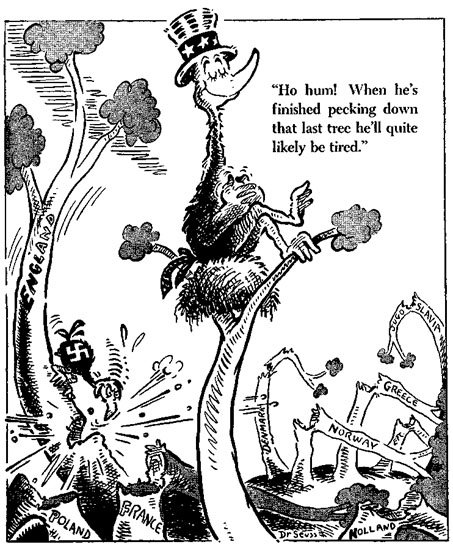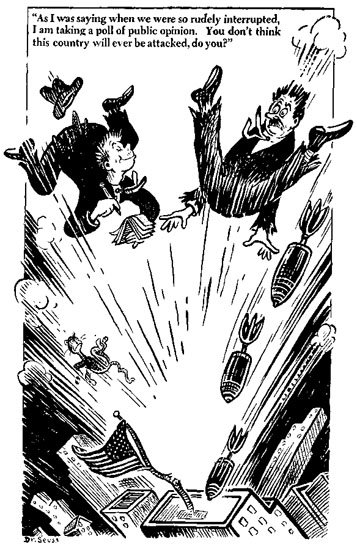The aim of this paper is to analyze a central theme surrounding Theodore S. Geisel’s miscellaneous political cartoons during his tenure with PM newspaper at the height of the second world war. Accordingly, I will address the topic of United States official policy of non-intervention right until the middle of the war for which Theodore, popularly known as Dr. Seuss, compiled several cartoons on the combined themes of isolationism, complacency and overconfidence. In this essay, I am going to address the thesis statement through three sample cartoons.
Before the war, Dr. Seuss was considered a popular writer, having authored several children’s classics such as How the Grinch stole the Christmas. During his spell as a cartoonist during the war, Dr. Seuss took a decidedly patriotic approach, utilizing his talent for wit and satire to whip up public opinion in favor of the American war effort, persistently criticizing those who took the contrary position.
Dr. Seuss published over 400 political cartoons between April 1941 and January 1943, ranging in topics from Anti-Semitism, US isolationism, appeasement of Nazis and also, racism against blacks. At a time when over 80 per cent of Americans opposed going to war with Germany, Dr. Seuss was a minority dissenter with his patriotic cartoons, not even hesitating to upbraid public role models such as celebrated aviator Charles Lindhberg who had taken a non-interventionist stance. To express his loathing for such people, Dr. Seuss wrote, “I found myself drawing pictures of Lindhberg the Ostrich.”
Clearly, the objective of Dr. Seuss’s satire was to confront his readers, challenging them for their defeatist mindset and tacit approval of the war. It stimulated him to draw political cartoons on the topic of American pacifism, expressing his voice on several recurring themes: America First, overconfidence, complacency, Neutrality act, inactivity, carelessness and more.
A key characteristic that separated Dr. Seuss from other war supporters of the time, was his total disregard for moral messages. Instead of preaching to the choir about their less than enthusiastic position in favor of the war, Dr. Seuss took the extreme position of poking fun at their fears, and insecurities. The objective of these cartoons was to make readers face up to their own suspicions of the war effort, forcing them to see how their non-interventionist stance was causing huge damage to the long-term interests of the United States.
At a time when most Americans were far removed from the actual scene of conflict (even though Pearl Harbor changed that position), few considered it practical to participate in foreign wars, or even extend friendly aid to countries like Britain. In their limited world view, America, for all purposes, was firmly secured, and practically immune to any foreign aggression.
Dr. Seuss took the opportunity to mock this attitude of complacency in a cartoon published on May 22, 1941 (Figure 1). It depicts America, among various nations sitting on top of trees, each tree being shown sawed by the “evil woodpecker” of Nazi Germany.

Country after country have been razed to the ground, including Poland, France, Norway, Holland, Greece, Yugoslavia and Denmark. The tree of Britain is portrayed as taking an honorable last stand even though its chances of survival against a determined woodpecker remains bleak. However, even as these disturbing events remain in plain view, the tree of America, in a defiant air of complacency, remains unaffected, fanning its misplaced sense of security through a self-congratulatory remark, “Ho hum! When he’s finished pecking down that last tree, he’ll quite likely be tired!”
The cartoon has been a direct affront to the sensibilities of the average American who would have been smug thinking that the United States was invincible, and not even the combined might of Axis-led Europe can possibly have the capability of launching a direct attack on American soil.
Dr. Seuss’s cartoon challenged this misplaced sense of complacency, resting his opinion on the fact that America could not forever afford to remain a lonely island, oblivious to the plight of its fellow brethren in friendly European countries. This cartoon tries to drive home the implicit message that the time to act against the Nazis should not be delayed forever; sooner or later, Americans must gather all their resources to take a definite stand against the wanton mayhem that had been wrecking Europe apart.
Another hard-hitting cartoon that railed against the sense of optimism and overconfidence of the average American, appeared on August 1, 1941 (Figure 2), weeks before the Pearl Harbor incident. This cartoon is surprisingly portentous in its eventual description of events that led to Pearl Harbor.

It is shown that even as rockets and bombs burst right on top of an urban American landscape, two men are diving straight into the ensuing rubble through the action of downward gravitation pull. One of them is mildly shaken, unable to figure out the chaos and disturbance lying ahead. The other one, however, is still not past his strong sense of optimism, casually remarking, “As I was saying when we were so rudely interrupted, I am taking a poll of public opinion. You don’t think this country will ever be attacked, do you?”
The cartoon was brilliant in its portrayal of both the fence-sitter (the man who is visibly shaken but still not getting into the decisive mode of clamoring for action against the enemy) as well as the eternal optimist whose sense of security could not have possibly been undermined by the destruction being caused, as long as the situation did not affect him personally.
Without clarifying the issue through lucid details, Dr. Seuss uses his gift of humor to expose the untenable positions of a large demographic of American society. This cartoon unconditionally tries to state the fact that overconfidence is going to be detrimental to the long-term ability of America to protect itself from foreign powers.
In continuation of his political commentary, Dr. Seuss became a firm critic of isolationism, a belief that the United States, by virtue of several factors such as its isolated geography, manifest destiny, the will of God, and historical separation from Europe, could somehow remain unaffected by the events taking place in other parts of the world. This was not only wishful thinking on part of the isolationists, but extremely distant from reality. For instance, several American ships en route to Europe were being already singled out for attacks by German U-boats.
Apart from American trading interests being at stake, there was a real threat to American national sovereignty because of a recent German invasion of Russia. The danger of Russia falling to German hands was real if one considered the advanced state of preparedness of the Nazi war machinery. If Russia fell, Hitler’s ambitions would naturally rise to go the next level up seeking world domination.
In lieu of this ham-fisted thinking, Dr. Seuss drew a cartoon on May 15, 1941 (Figure 3). Uncle Sam is shown lying on a bed, at arm’s length from another bed depicting Europe. The European bed has a crumpled sheet, its inhabitants huddled together as in a concentration camp, suffering from various ailments such as “Hitleritis,” “Blitzpox,” “Nazi fever,” “Stalinitch,” “Fascist fever,” and “Italian mumps.”

Even as the air surrounding the bed is riddled with all these forms of contagious infections, Uncle Sam is shown sleeping like a baby, unmindful of his surroundings, confident in the belief that no infection would possibly ever reach him, “Ho hum, no chance of contagion.” To further assert his wishful thinking, the caricature opines, “What a lucky thing we’ve got separate beds”.
By the middle of 1941, isolationism was steadily losing steam among the left-wing Roosevelt administration but the public was still largely opposed to pursuing a radical approach to the problem. Many Americans were in fact, opposed to sending friendly aid to the United Kingdom under the Lend-Lease agreement because of German intimidation tactics.
At such a juncture, even pragmatic thinkers began cozying to the position that America could no longer afford to remain silent on the realities of a rapidly deteriorating world order. The time had come to face up to the challenges and retaliate against the aggressive posturing of foreign powers.
The three sample cartoons described here, represent a significant transient stage, reflecting America’s role during the war. The cartoons not only inspired a call of duty and an orientation for action, but packed a black humor punch with its flippant approach to the gravity of the situation. The popularity of the cartoons among the public caused many to assess the real situation at hand, and how it affected their daily lives. Being restricted to only one newspaper publication on the East coast, they were hardly used for propaganda purposes but nonetheless, carried the same impact.
Clearly, the war was at America’s doorsteps; Dr. Seuss made everyone see through the flaws of the argument that the country was somehow immune to the great changes sweeping across half the world. The importance of political cartoons in that era can be seen in the light of the fact that newspaper readership was at an all-time high. Even though many Americans were opposed to the war, while many others were interested in developments taking place in Europe because of several factors such as having relatives in Europe, a desire to stay up-to-date about world happenings and the collective loathing many shared for Adolf Hitler.
Dr. Seuss’s cartoons made them see the world through a delicate touch of humor. It made them question their self-centered beliefs and with the advent of the Pearl Harbor incident, come out openly in support of American military action.
In conclusion, it can be suggested that if a random poll was conducted on some of the top decisive factors that enabled the Roosevelt administration to turn the tide of American public opinion in favor of its war efforts, the impact of political cartoons such as Dr. Seuss’s should make it into the list somewhere. After the war, several of Dr. Seuss’s cartoons were compiled into book collections, movies and other forms of print-visual media.
Reference List
Charney, Maurice. 2005. Comedy: A Geographic and Historical Guide Vol 1. London: Greenwood Publishing Group.
Dewey, Donald. 2007. The Art of Ill Will: The Story of American Political Cartoons. New York: NYU Press.
Fensch, Thomas. 2005. Of Sneetches and Whos and the Good Dr. Seuss: Essays on the Writings and Life of Theodor Geisel. New York: McFarland.
Foner, Eric. 2004. Give Me Liberty!: An American History. Houston, TX: W.W. Norton.
Nel, Philip. 2005. American Icon. New York: Continuum International Publishing Group.
Pavlik, John Vernon and McIntosh, Shawn. 2004. Converging Media: An Introduction to Mass Communication. New York: Pearson.
UC San Diego Library. A Catalog of Political Cartoons by Dr. Seuss, 2011. Web.